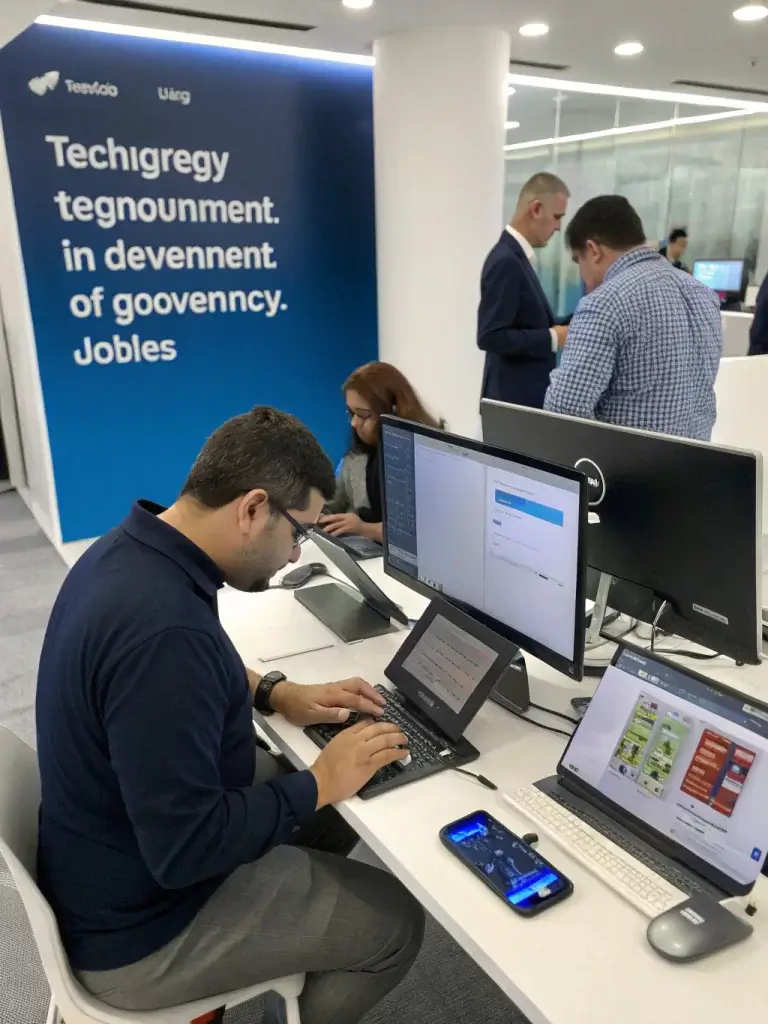Introduction
government jobs it jobs Did you know that federal IT workers earn an average of 22% more than their private sector counterparts? This surprising statistic reveals why government jobs in IT sectors have become increasingly competitive, with the federal government employing over 90,000 IT professionals nationwide. Despite this appeal, many qualified candidates miss opportunities in government IT jobs due to unfamiliarity with the unique application process. Whether you’re a cybersecurity specialist, network administrator, or software developer, navigating the path to government IT jobs requires strategic planning and insider knowledge. This comprehensive guide breaks down the seven essential steps to securing your ideal government IT position, combining industry insights with practical application techniques to give you a competitive edge.
Table of Contents
Core Features of Government IT Jobs
Government IT positions offer unique benefits that set them apart from private sector roles:
- Job Security: Government IT jobs typically provide greater stability than private sector positions, with layoff rates 4x lower than corporate environments.
- Competitive Benefits: Comprehensive healthcare plans, retirement packages with pension options, and generous paid leave structures.
- Work-Life Balance: Many agencies adhere to standard 40-hour workweeks with flexible scheduling options and telework opportunities.
- Mission-Driven Work: Opportunities to support critical national infrastructure, public services, and projects with meaningful societal impact.
- Career Advancement: Structured promotion pathways and opportunities for cross-agency mobility.
- Professional Development: Access to specialized training, certifications, and educational reimbursement programs.
Specifications & Requirements
Before applying for government IT jobs, understand these core requirements:
Educational Qualifications:
- Bachelor’s degree in Computer Science, Information Technology, or related field (minimum for GS-7 level positions)
- Master’s degree often preferred for GS-9 and above positions
Technical Certifications:
- Security clearances (depending on position sensitivity)
- CompTIA Security+, CISSP, or CEH for cybersecurity roles
- Microsoft, Cisco, or AWS certifications for infrastructure positions
- Project Management Professional (PMP) for IT management roles
Citizenship Requirements:
- U.S. citizenship required for most federal IT positions
- Background checks, including credit and criminal history review
How to Land Your Government IT Job
Step 1: Research Available Positions
Begin by exploring the diverse landscape of government IT jobs across federal, state, and local levels. USAJOBS.gov lists approximately 2,500 federal IT positions at any given time, spanning 100+ agencies.
- Use specialized government job boards: USAJOBS.gov, Clearancejobs.com, and Governmentjobs.com
- Set up job government jobs it jobs alerts with specific IT keywords (cybersecurity, network administration, data analysis)
- Research specific agencies aligned with your technical expertise and interests
- Review job series codes (e.g., 2210 for IT Management, 1550 for Computer Science)
Step 2: Tailor Your Resume for Government Format
Government resumes differ significantly from private sector resumes, typically running 3-5 pages instead of the traditional 1-2 pages.
- Include detailed descriptions of relevant experience, with quantifiable achievements
- Map your skills to the specific job announcement’s required Knowledge, Skills, and Abilities (KSAs)
- Use the Resume Builder tool on USAJOBS.gov to ensure proper formatting
- List all relevant education, certifications, and clearances prominently
- Include citizenship status and veteran preference eligibility if applicable
Step 3: Master the Federal Application Process
Government job applications involve multiple components beyond the standard resume submission.
- Complete all questionnaires thoroughly and accurately
- Prepare narrative responses to KSA questions in advance
- Gather supporting documentation (transcripts, certification copies, SF-50 forms if previously employed)
- Apply before deadlines, as extensions are rarely granted
- Create organized application packets for government jobs it jobs each position, tailored to specific requirements
Step 4: Prepare for Assessment Tests
Many government IT jobs require specialized assessments to evaluate technical knowledge and competencies.
- Study relevant technical domains based on job requirements
- Practice coding tests for developer positions
- Review cybersecurity frameworks (NIST, FISMA) for security roles
- Prepare for situational judgment tests measuring problem-solving abilities
- Practice behavioral interview questions focusing on government-specific scenarios
Step 5: Navigate the Interview Process
Government interviews are typically structured and formal, often involving panels rather than one-on-one conversations.
- Research the agency’s mission, strategic plan, and current IT initiatives
- Prepare STAR method responses (Situation, Task, Action, Result) for behavioral questions
- Demonstrate knowledge of federal IT regulations (FISMA, FedRAMP, Section 508)
- Bring additional copies of your credentials and documentation
- Ask thoughtful questions about the role’s impact on agency objectives
Step 6: Understand the Security Clearance Process
Approximately 60% of federal IT positions require some level of security clearance, which can extend your hiring timeline.
- Complete all security paperwork promptly and accurately
- Prepare a list of references and previous addresses
- Disclose all international contacts and travel
- Be prepared for background investigations and polygraph tests for higher clearance levels
- Maintain clean financial records, as debt issues are the leading cause of clearance denials
Step 7: Negotiate and Accept Your Offer
Even within structured government pay scales, some negotiation is possible.
- Research the General Schedule (GS) pay scale for your position level and location
- Inquire about step increases within your grade based on experience
- Discuss student loan repayment programs and recruitment incentives
- Review telework and flexible scheduling options
- Understand probationary periods and performance evaluation criteria
Performance Insights
Government IT professionals report 28% higher job satisfaction compared to private sector counterparts, according to recent OPM Federal Employee government jobs it jobs Viewpoint Surveys. This satisfaction correlates with:
- 94% of federal IT workers reporting meaningful work impact
- 87% indicating satisfaction with work-life balance
- Average tenure of 8.2 years compared to 4.1 years in private sector IT roles
Pros and Cons
Pros:
- Exceptional benefits package valued at approximately 47% of salary
- Clear career progression pathways
- Contributing to critical national infrastructure and public service
- Opportunities for specialized training and certifications
- Strong job security and retirement benefits
Cons:
- Potentially slower hiring government jobs it jobs process (4-9 months on average)
- More bureaucratic work environments
- Possibly lower base salaries than top-tier private companies
- Rigid promotion structures in some agencies
- Complex security clearance requirements
Mitigation Strategies:
- Apply to multiple positions simultaneously to overcome lengthy hiring timelines
- Explore “direct hire authority” positions with expedited processes
- Research agencies with modernization initiatives for more innovative environments
- Consider starting with contractor positions to gain government experience faster
Use Cases
Cybersecurity Professional:
Transition from private sector consulting to the Cybersecurity and Infrastructure Security Agency (CISA), where you’ll protect critical national government jobs it jobs infrastructure from emerging threats.
Software Developer:
Apply your coding skills at the U.S. Digital Service, building applications that millions of citizens rely on for essential government services.
Data Scientist:
Leverage your analytical expertise at the Census Bureau or NIH, where your data models directly inform public policy decisions and research priorities.
IT Project Manager:
Lead digital transformation initiatives at the Department of Veterans Affairs, improving service delivery for those who served our country.
Common Mistakes to Avoid
- Submitting generic applications – Fail to customize government jobs it jobs your resume for specific government postings
- Overlooking questionnaire importance – Rush through self-assessment questionnaires that determine if applications advance
- Missing application deadlines – Government deadlines are strict, with positions often closing after receiving a predetermined number of applications
- Inadequate documentation – Failing to provide required supporting documents like transcripts or certification copies
- Underestimating security clearance processes – Not allowing sufficient time for background investigations
Maintenance & Updates Tips
Once employed in government IT, maintain your competitive edge:
- Pursue higher-level security clearances to expand job opportunities
- Utilize government training allowances for advanced certifications
- Join interagency working groups to expand your professional network
- Monitor recompete cycles for contract positions if applicable
- Stay informed about government-wide IT initiatives and modernization efforts
Conclusion
Securing government IT jobs offers a unique blend of government jobs it jobs stability, purpose, and professional growth that’s increasingly attractive in today’s uncertain job market. By following these seven strategic steps and leveraging the specific insights provided, you’ll navigate the complex federal hiring process more effectively than most candidates. The investment in properly understanding government hiring processes pays dividends through rewarding careers building and protecting the technology infrastructure that powers our nation. Take the first step today by exploring current openings on USAJOBS.gov and beginning to reshape your application materials for government consideration.
FAQs
Q: How long does the government hiring process typically take for IT positions?
A: The process generally takes 4-9 months from application to start date, with security clearance requirements potentially extending this timeline.
Q: Are government IT jobs only available in Washington, DC?
A: No, government IT jobs exist nationwide, with approximately 60% of federal IT positions located outside the DC metro area.
Q: Can I negotiate salary for government IT positions?
A: While base salaries follow the General Schedule (GS), you may negotiate starting grade level, step within grade, and sometimes relocation incentives.
Q: Do I need a security clearance before applying?
A: No, clearances are typically sponsored by the hiring agency after a contingent job offer, though having an active clearance can expedite the process.
Q: What’s the difference between direct hire and competitive service positions?
A: Direct hire positions use streamlined hiring processes for hard-to-fill roles, often reducing hiring time by 60% compared to competitive service positions.



